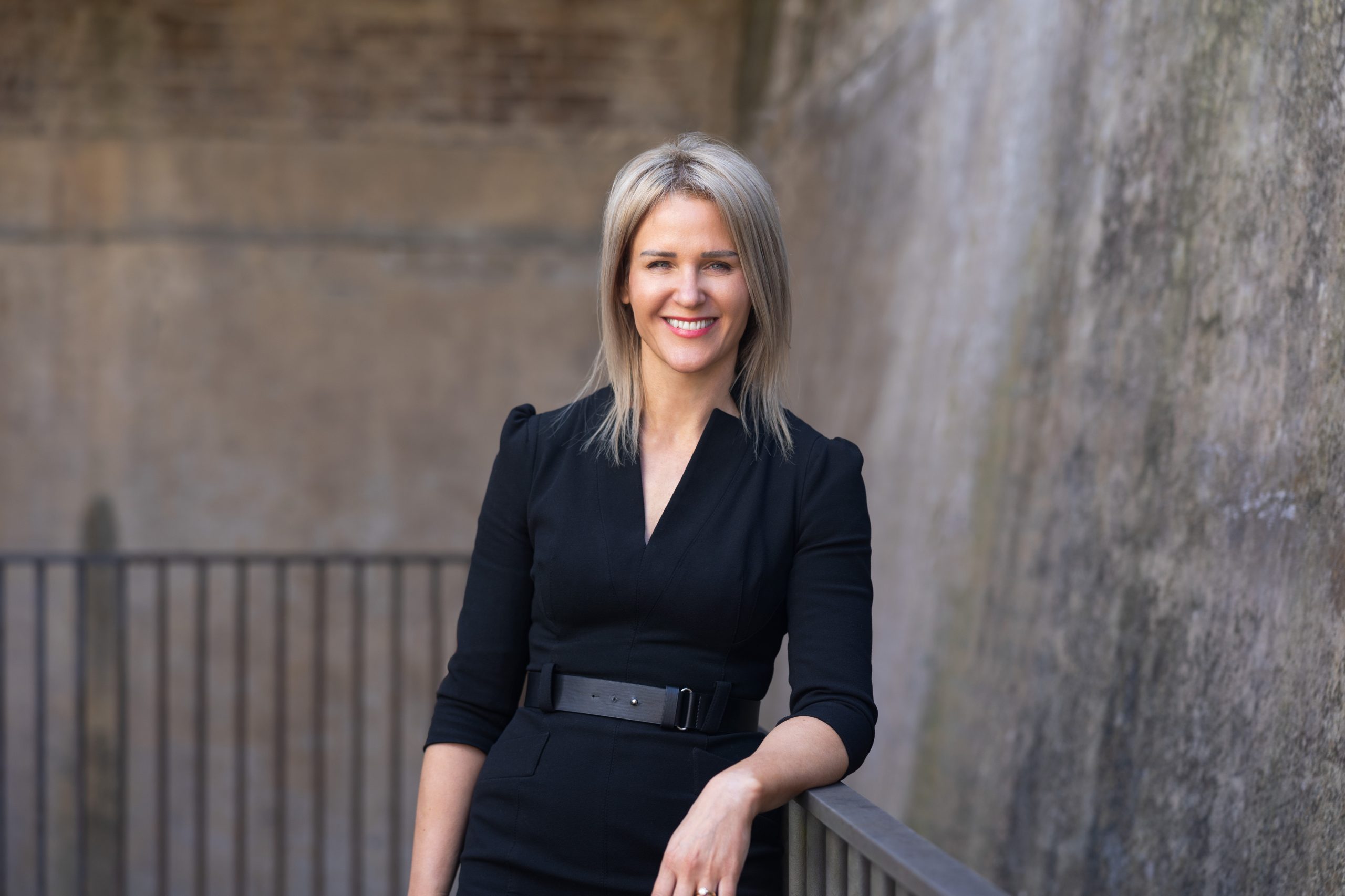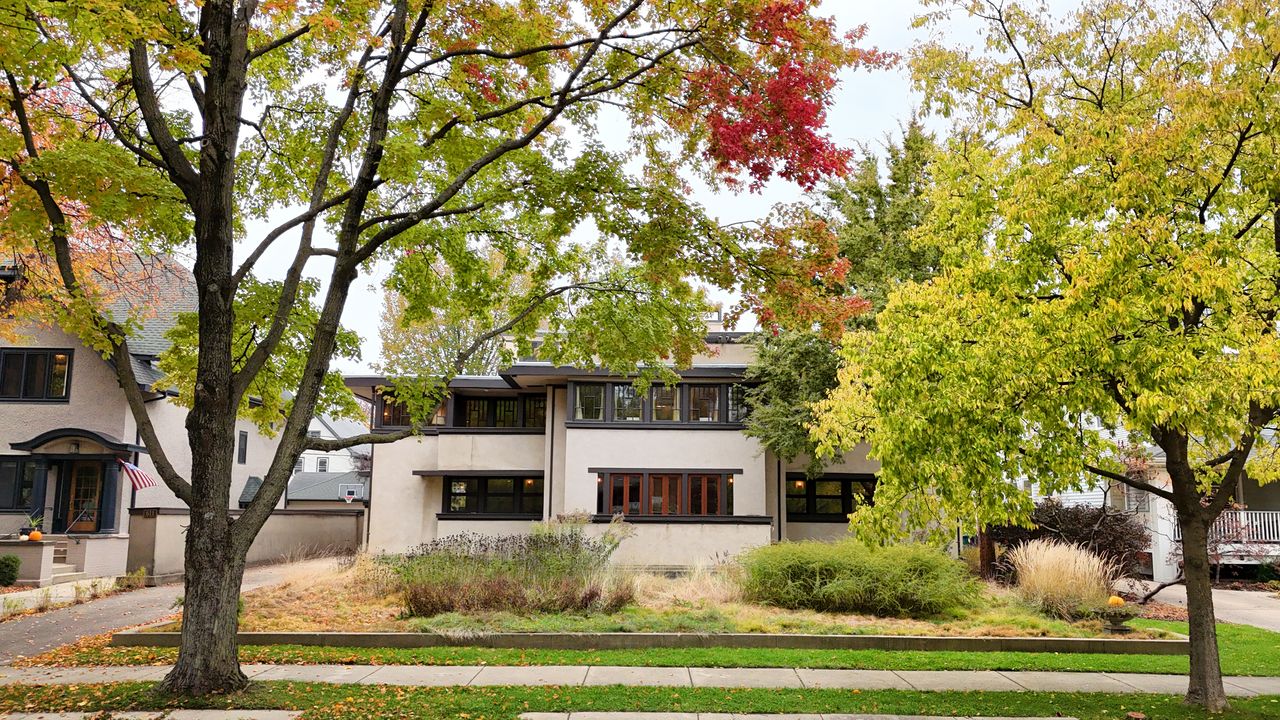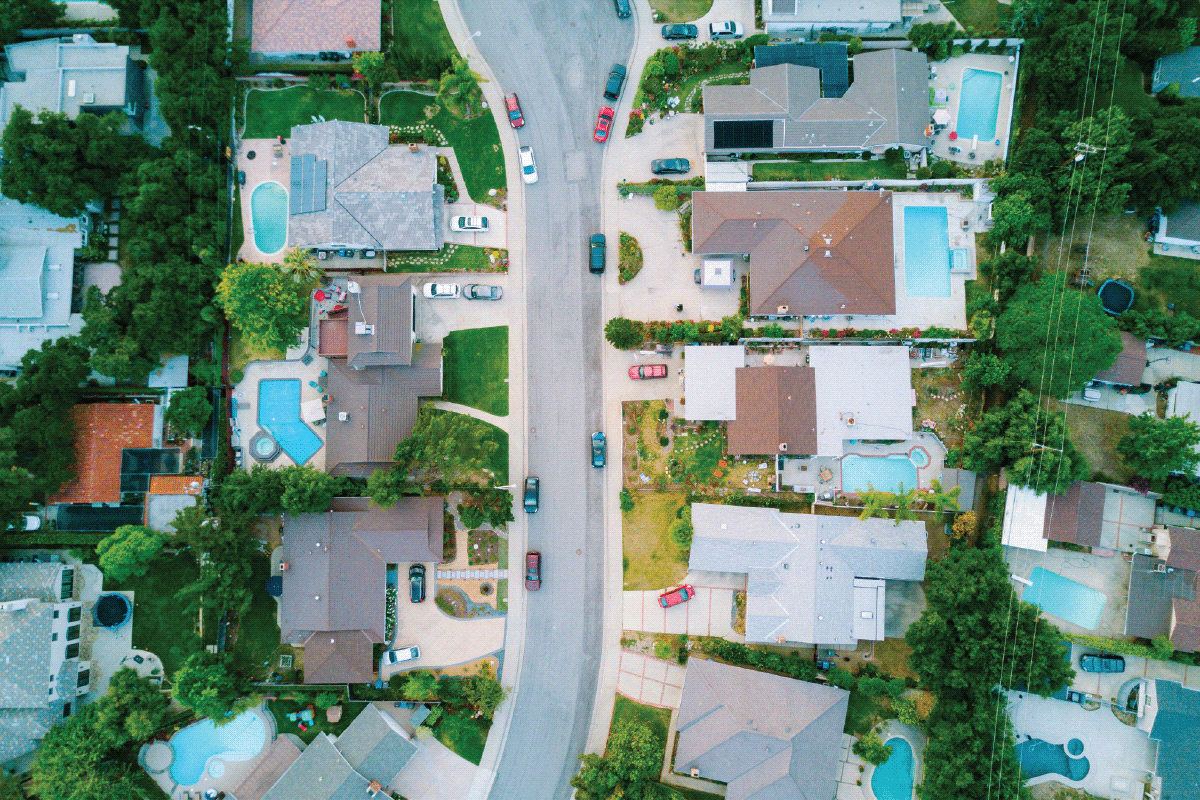Inside the $800,000 Experiment to Turn a Frank Lloyd Wright Into a Net-Zero Energy Home
A native New Yorker launched an ‘environmentally focused’ renovation to bring an architecturally significant Illinois home into the 21st century
“I was not planning to buy a Frank Lloyd Wright house,” says Samantha Lotti, who grew up in a Manhattan apartment, studied at the University of Chicago, and then spent five post-college years running her family’s farm in Tuscany. So in 2016, when she heard that the Oscar B. Balch House, one of more than two dozen Wright buildings in Oak Park, Ill., was for sale, she was only vaguely interested. But she did go look. And when she entered the main living space of the 1911 prairie-style house, which is named for its first owner, she says, “I fell in love.” Among the things that moved her were the size of the windows and the proportions of the rooms. The ceilings are low, “almost compressive,” she says, “which is intended to force you to engage with what’s outside the house. And, thanks to the windows, you feel like you’re outside when you’re inside.”
Within weeks, she was in contract to buy the house for $1,126,800, about 10% below asking, which, to a New Yorker, seemed like a bargain. The house had a lot going for it. It is part of a gracious neighbourhood of historic residences, including Wright’s own Home and Studio. And it was in excellent condition, thanks to its previous owner, Tim Pearson, an accountant and construction company executive, who between 1999 and 2016 restored much of the original building while adding a very large kitchen and great room to the back of it. That increased the house’s size to 4,400 square feet without altering its symmetrical front elevation. Though the house is closely watched by Wright enthusiasts, the only parts of it with legal protection are two spectacular Wright-designed glass light fixtures that Pearson deeded to the Frank Lloyd Wright Building Conservancy. Lotti, 39, jokes that she could gut the entire house as long as she didn’t touch the fixtures.
But she’s not about to gut anything. Every morning, Lotti says, “I wake up in a work of art.”
Though not a very energy-efficient work of art. Its 49 single-paned windows, many with bits of coloured glass in abstract patterns, provided little insulation. Nor was there much insulation in the walls and roof. During a “polar vortex” in 2019, Lotti, who practices Chinese medicine in Oak Park, ran the gas-fired boiler-and-radiator heating system at full blast, and still couldn’t get the indoor temperature above 55 degrees. Air conditioning the house in summer was equally difficult. “It was so expensive,” she says. “At night I’d turn it on only if it was 90-plus degrees.” Lotti was disturbed not just as a homeowner paying the utility bills, but also as an environmentalist. So she set out to make the Wright house green. She hoped it could even reach “net zero,” meaning it produced as much energy as it consumed. Like most users of the phrase net zero, she didn’t count, on the consumption side, the energy that went into building and renovating the house, known as embodied energy.
“It is extremely unusual to do a historic restoration that is so environmentally focused,” says Marsha Shyer, who chairs the homeowner committee of the Frank Lloyd Wright Building Conservancy. Owners of historic houses often simply live with inefficiency as the price of authenticity.
Getting to net-zero would mean tightening the building envelope to reduce the need for heating and air conditioning. She began with the roof, which not only leaked when it rained but was also far from airtight. Redoing it cost about $55,000, which, Lotti says, is more than she would have paid if she had hired an ordinary contractor. Instead, she chose one who specialises in historic preservation. “You always have to go up a level for Frank Lloyd Wright,” she says. That’s true even though the roof, which is flat, is visible only from above.
Next she had to insulate the space below the roof. That meant tearing out the original second-floor ceiling, which gave Lotti a chance to solve another problem: The flexible ductwork over the house’s bedrooms rattled when the air conditioning was on. Lotti decided to install new, rigid ductwork for both heating and cooling. Once the ductwork was in place, it was time to fill the remaining ceiling cavities with insulation. Until recently, blow-in insulation often contained HFCs (hydrofluorocarbons) that emitted greenhouse gases far more damaging to the environment than CO2. Instead, Lotti’s contractor used recently developed hydrofluoro olefin (HFO) spray foams, which are far less greenhouse gas-intensive.
Then it was time to restore the second floor ceilings, which had a sandy finish specified by Wright. To Lotti’s surprise, rebuilding the ceilings and giving them just the right texture cost about $50,000.
The other big contribution to making the house tighter was insulating its 49 single-pane windows. After speaking to contractors and preservationists about how to best achieve that, she decided to install interior storm windows. A carpenter spent months during the pandemic making pine-framed storm windows for a house where no two windows were precisely the same size (mostly due to settling). The storm windows are stunningly well-made; they are barely visible from inside or outside the house. Lotti spent $142,000 on those and other window and door restorations.
Then came the biggest job of all: replacing her gas-burning furnace and water heater with a geothermal system. That involved drilling six 450-foot holes in the front yard, running pipes into and out of the holes, then surrounding the pipes with charcoal, a good conductor of heat, bentonite, a kind of clay that expands as it dries, and sand. Water circulating through the pipes reaches a temperature of about 59 degrees. From there, just a bit of energy is needed to make it slightly hotter, for heating, or colder, for air conditioning. Digging the geothermal wells, running the pipes through them, and connecting those pipes to the forced-air system cost about $64,000, which was reduced by a 26% Illinois rebate. Lotti had to redo part of the basement floor ($29,000) to support the manifolds, which connect the geothermal wells to the house’s heating and cooling systems, as well as three big water-storage tanks, two bilge pumps, and other new equipment ($49,000). It cost $132,000 to add ductwork throughout the house—allowing for forced air heating and cooling. Electrical wiring for the system was another $26,000. Altogether, the heating and air conditioning improvements—from geothermal wells to ductwork—cost about $300,000.
Installing the geothermal system means Lotti no longer uses gas to heat the house, but it didn’t lower her electric bill. “It takes electricity to pump the water down 450 feet and back up 450 feet,” she says.
Lotti also took on several projects purely for aesthetic reasons, such as repainting the Greek key motif on the house’s exterior in its original grey colour. Another improvement was sybaritic: Lotti turned an enclosed porch on the back of the second floor into a sauna. Pearson had laid the groundwork for that and other nonessential projects.“ It’s because of him that I could do what I did,” Lotti says.
Before the renovation began, Lotti subjected the house to a blower door test, which measures the permeability of the building envelope. She performed another one almost three years later. The goal, she says, was to see if installing custom interior storm windows, insulating the second-floor ceilings and replacing the roof made the house tighter. It did, but not enough. “We failed,” says Lotti, “but we came much closer to passing than before.” The house still leaked like a sieve, mostly through the exterior walls. But the cost of insulating those walls, she says, was “prohibitive.” As a result, she says, “The house may never be net zero.”
Installing rooftop solar panels would have helped the house meet that goal. But she couldn’t have installed the solar panels while the roof and the ceiling (including the new ductwork) were being repaired. Once the ductwork was in place it made sense to complete the geothermal system. Then, when it was finally time to install the solar panels, workers had been in and out of the house nearly every day for three years. Lotti decided she needed a break.
She still hopes to install the solar panels, which, she believes, will cost about $27,000 before tax rebates. She expects utility bill savings would defray that cost over a period of years.
Altogether, Lotti spent about $800,000 on the house, a figure that includes engineering and site management fees and the cost of replacing a sewer line that broke when the geothermal wells were being dug.
So what had she accomplished? She had made the house all electric, with the exceptions of her two wood-burning fireplaces. An all-electric house has the potential to operate with almost no carbon emissions. It just takes a clean source of electricity, like the solar panels she hopes to install on the roof. Lotti also gained a lot of experience, which Shyer, herself the owner of a Frank Lloyd Wright house, has chronicled on the website of the Frank Lloyd Wright Building Conservancy, savewright.org. Says Shyer, “Samantha is using her house as a model for environmentally conscious historic preservation. It has certainly caught the attention of the Frank Lloyd Wright homeowner community.”
Lotti herself has chronicled her efforts in a series of highly informative Instagram posts. Looking back on the three years she dedicated to upgrading the house, she says, “We discovered what was possible, which is that the house could become significantly more energy efficient.” She adds, “Just like in medicine, we experiment. We come up with an idea that we think is going to be a solution, and then we discover that it isn’t. Humanity is all about trial and error. You don’t know unless you try.”
 Copyright 2020, Dow Jones & Company, Inc. All Rights Reserved Worldwide. LEARN MORE
Copyright 2020, Dow Jones & Company, Inc. All Rights Reserved Worldwide. LEARN MORE
This stylish family home combines a classic palette and finishes with a flexible floorplan
Just 55 minutes from Sydney, make this your creative getaway located in the majestic Hawkesbury region.
The Albanese Government is initiating a range of measures to tackle the housing crisis, but experts fear it’s not enough
The $11.3 billion Homes for Australia plan unveiled in this week’s Federal Budget includes an additional $1 billion in funding – on top of $500 million previously pledged – to help the states and territories fast-track the building of ‘enabling infrastructure’ such as new roads, sewers and energy, water and community infrastructure to create more areas for buyers to build their new homes.

To support this goal, the Federal Government has also committed $90.6 million to grow Australia’s construction workforce, including 20,000 new fee-free places at TAFE and VET vocational colleges, as well as more skilled migrant visas. CoreLogic research director Eliza Owen commented: “This could add to labour supply to the tune of 22,000 workers, representing 1.7 percent growth in an industry where employment had an average quarterly increase of 0.7 percent over the past decade.”
More construction workers are desperately needed not only to help the Federal Government reach its target of 1.2 million new homes within five years, but also to offset the impact of construction company insolvencies. Ray White economist Nerida Conisbee points out that construction insolvencies continue to rise, with the latest ASIC figures showing 2,758 construction companies entered external administration over the 12 months to 31 March 2024.

Prime Minister Anthony Albanese said the budget encouraged the states and territories to “kick start building”. He commented: “This Budget means more tradies, fewer barriers to construction, less talk and more homes. This isn’t about one suburb or one city or one state. It’s a challenge facing Australians everywhere and it needs action from every level of government.”
The Federal Government is also seeking to reduce demand in the private rental market following a 43.5 percent surge in the national median rent from $437 per week in August 2020 to $627 per week today, according to CoreLogic. The budget provides money for more social housing, plus a plan to make universities build more student accommodation, thereby removing some demand in the private rental market from low-income workers and domestic and international students.
Budget measures include an additional $423.1 million for the National Agreement on Social Housing and Homelessness, taking total funding to $9.3 billion over five years, under which more social housing will be built and existing housing repaired. REA senior economist Paul Ryan said: “All up, the government expects to support the building of 55,000 new social and affordable homes by 2029 – representing a 12 percent increase in the total number of available homes across the country.”
The plan to legislate new requirements for universities to build more accommodation follows a huge surge in immigration, with an almost 550,000 net increase in migrants over the 12 months to 30 September 2023, the bulk of which were international students and temporary workers.
Commonwealth Rent Assistance is being increased for the second year by 10 percent this time, following a 15 percent increase in last year’s budget. The two boosts represent about a $35 per week increase in assistance to almost one million Australians. The Budget also includes $1 billion for crisis and transitional accommodation for domestic violence victims and youth in distress.
AMP chief economist Dr Shane Oliver said the budget’s housing measures were unlikely enough to meet the goal of building 1.2 million new homes over five years. Dr Oliver said the supply shortfall was set to remain “unless immigration plunges”. Treasurer Jim Chalmers says net overseas migration next year is expected to be half what it was this year.
Dr Oliver said the budget’s housing measures were also unlikely to alter the outlook for home prices. He expects modest growth this year. Median dwelling values have already risen 2.2 percent between January 1 and April 30, following an 8.1 percent lift in 2023.
Just 55 minutes from Sydney, make this your creative getaway located in the majestic Hawkesbury region.
This stylish family home combines a classic palette and finishes with a flexible floorplan






















